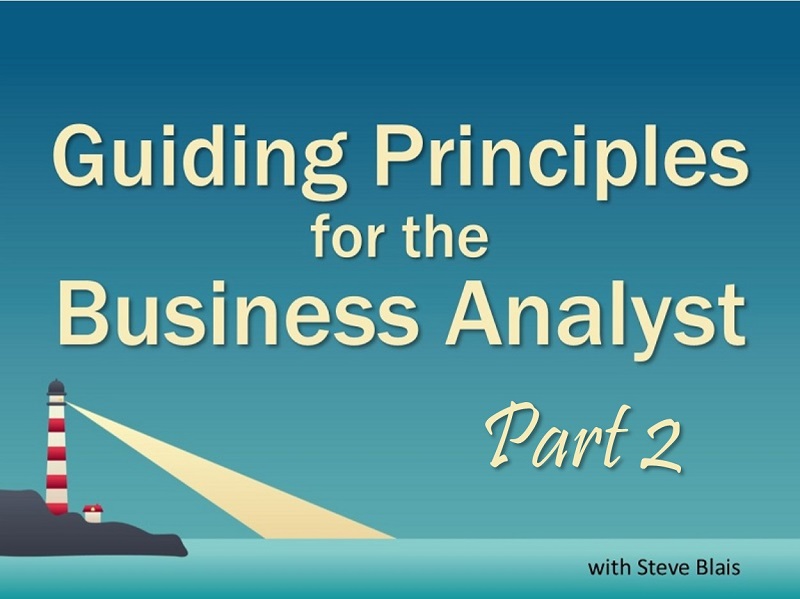In part 2 of this interview, author and consultant Steve Blais shares with us the remainder of his 11 principles of the business analyst, which provides guidance as to what a business analyst should do to achieve success.
After listening to this episode, you'll understand:
- How to apply Miller’s Law for better elicitation
- Why transition requirements are as important as solution requirements
- How to focus on benefits realization
- Why some Agile leaders believe a BA isn’t needed
Show Notes
This is part 2 of a two part episode. To listen to part 1, click here. Part 1 covered the first four principles which are:
- Principle 1: Focus On the Product
- Principle 2: First Define the Problem and Then the Solution
- Principle 3: Users Do Not Have Requirements
- Principle 4: Focus On Information Not Individuals
Principle 5: Separate Elicitation from Analysis
When you elicit information, don’t analyze. When you’re analyzing, don’t add new information.
If we analyze information by asking analytical questions as we’re receiving information, the stakeholder will feel judged. In this case, you’ll receive less information and people will be less forthcoming in sharing their knowledge.
We don’t want to do anything that would be detrimental to the flow of information.
Instead, apply Miller’s law which states “If you truly want to understand what a person is saying, first assume that it’s true and then try to find out what it is true of”.
Failing to apply this principle could lead to biases, assumptions, and incorrect or missing information.
Principle 6: Improve the Process First, Then Add Technology
Often, the solution to the problem is not a technology solution. It may be a communication or process issue, in which case a technical solution won’t solve the problem.
Look for a non-technical solution first.
We should also come up with more than one potential solution to a problem. By doing so, we’ll be forced to look at other options (including non-technical solutions) and avoid confirmation bias.
Principle 7: Communicate, Cooperate, Collaborate
The Business Analysts primary job is a communicator and collaborator. That’s how you solve problems.
Constant communication, collaboration, and betting input is critical to success as a Business Analyst. This also helps in the areas of negotiation, influence, mediation, presentations, and conflict resolution.
You’ll be much more successful if you work collaboratively with others. Don’t let documentation substitute for communication and collaboration.
Principle 8: The Business Analyst Owns the Solution Requirements
We need to adopt the mindset that we own the requirements. No one can change the requirements except you.
Ownership of the requirements includes the responsibility if something is wrong.
Principle 9: Gain Acceptance As Well As Approval
Get confirmation of all of the requirements prior to seeking approval. Once you’ve discussed and confirmed the requirements with stakeholders, then you can request approval from those with authority to approve the requirements.
Often, requirements approvers will seek input from those stakeholders before submitting their approval. Gaining acceptance of your requirements prior to asking for approval makes the approval process easier.
Principle 10: Make the Business Community Ready For the Product
Don’t forget about transition requirements. Consider what is needed to make sure the business or customer is ready to use the solution.
Transition requirements may include training, documentation, and creating awareness in addition to a change management process. We need to prepare the user for the solution before we implement it.
Principle 11: Measure Twice, Cut Once
As Business Analysts, we want to measure, cut, and then measure again. We need to understand the problem and identify metrics to determine outcomes, implement a solution, and then measure those areas again to see what kind of an impact the solution had.
Benefits realization is a key focus for successful Business Analysts. Before we implement a solution, we need to understand how to measure success and track those metrics before and after we implement the solution.
There are several categories of measurements you may use to determine the impact of your solution including intrinsic, satisfaction, and value measurements.
You’re job isn’t about writing requirements. It’s about making improvements to the business. The way you show the improvement is by measuring it before the solution and them measuring after.
Listen to the full episode to understand how to apply the 11 principles in your role and why some people believe a BA isn’t needed in a Agile environment.
Your Homework
Focus on critical thinking and apply Miller’s Law. You can do this by asking questions about your own thinking. Doing so not only improves the quality of your thinking, it also helps remove biases. Building your critical thinking skills also helps improve your problem solving and decision making ability.
Links mentioned in this episode:
- Episode 126 – Part 1 of this interview
- Steve’s website EssenceoftheBA.com
- Get Steve’s book, Business Analysis: Best Practices for Success

Steve Blais
Author and Consultant
Steve Blais is an author and consultant with almost 50 years’ experience in business analysis, project management, and software development. He provides consulting services to companies developing business analysis processes. Steve was on the committee for the IIBA’s BABOK Guide version 3.0 and is the author of Business Analysis: Best Practices for Success.
Thank you for listening to the program
To get more valuable content to enhance your skills and advance your career, you can subscribe on iTunes and other podcatchers.
Also, reviews on iTunes are highly appreciated! I read each review and it helps keep me motivated to continue to bring you valuable content each week.








Trackbacks/Pingbacks